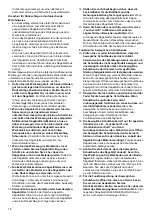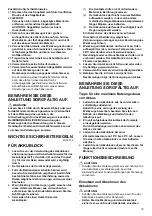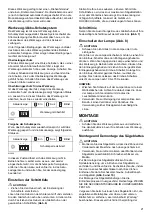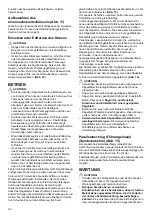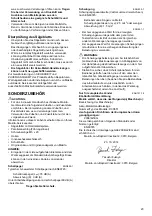
8
the hex bolt counterclockwise. Then remove the hex bolt,
outer flange and blade.
(Fig. 9 & 10)
To install the blade, follow the removal procedure in
reverse. BE SURE TO TIGHTEN THE HEX BOLT
CLOCKWISE SECURELY.
When changing blade, make sure to also clean the upper
and lower blade guards of accumulated metal chips as
discussed in the Maintenance section. Such efforts do not
replace the need to check lower guard operation before
each use.
Hex wrench storage (Fig. 11)
When not in use, store the hex wrench as shown in the
figure to keep it from being lost.
Installing or removing hook
CAUTION:
• Never hang the tool on a waist belt or like. Dangerous
accidental cut may result.
• Never hook the tool at high location or on potentially
unstable surface.
The hook can be installed on the motor side of the tool as
illustrated. To install the hook, insert it into a groove on the
tool housing, and secure it with the screw. To remove the
hook, loosen the screw and take it off.
(Fig. 12)
OPERATION
CAUTION:
• Always insert the battery cartridge all the way until it
locks in place. If you can see the red part on the upper
side of the button, it is not locked completely. Insert it
fully until the red part cannot be seen. If not, it may
accidentally fall out of the tool, causing injury to you or
someone around you.
• Be sure to move the tool forward in a straight line
gently. Forcing or twisting the tool will result in
overheating the motor and dangerous kickback,
possibly causing severe injury.
• If the tool is operated continuously until the battery
cartridge has discharged, allow the tool to rest for
15 minutes before proceeding with a fresh battery.
• Never twist or force the tool in the cut. This may cause
motor overload and/or a dangerous kickback, resulting
in serious injury to the operator.
• Always wear eye protection or goggle before operation.
Hold the tool firmly. The tool is provided with both a front
grip and rear handle. Use both to best grasp the tool. If
both hands are holding the tool, they cannot be cut by the
blade. Set the base on the workpiece to be cut without the
blade making any contact. Then turn the tool on and wait
until the blade attains full speed. Now simply move the
tool forward over the workpiece surface, keeping it flat
and advancing smoothly until the cutting is completed.
(Fig. 13)
To get clean cuts, keep your cutting line straight and your
speed of advance uniform. If the cut fails to properly follow
your intended cut line, do not attempt to turn or force the
tool back to the cut line. Doing so may bind the blade and
lead to dangerous kickback and possible serious injury.
Release switch, wait for blade to stop and then withdraw
tool. Realign tool on new cut line, and start cut again.
Attempt to avoid positioning which exposes operator to
chips and particles being ejected from the tool. Use eye
protection to help avoid injury.
The sight grooves in the base makes it easy to check the
distance between the front edge of the blade and the
workpiece whenever the blade is set to the maximum
depth of cut.
(Fig. 14)
CAUTION:
• Do not use a deformed or cracked blade. Replace it
with a new one.
• Do not stack materials when cutting them.
• Do not cut hardened steel, wood, plastics, concrete,
tile, etc.
Cut only mild steel, aluminum and stainless
steel with a suitable saw blade.
• Do not touch the blade, workpiece or cutting chips with
your bare hand immediately after cutting, they may be
extremely hot and could burn your skin.
•
Always use the blades appropriate for your job.
The use of inappropriate blades may cause a poor
cutting performance and/or present a risk of personal
injury.
Rip fence (guide rule) (Optional
accessory) (Fig. 15)
The handy rip fence allows you to do extra-accurate
straight cuts. Simply slide the rip fence up snugly against
the side of the workpiece and secure it in position with the
clamp screw on the front of the base. It also makes
repeated cuts of uniform width possible.
MAINTENANCE
CAUTION:
• Always be sure that the tool is switched off and the
battery cartridge is removed before attempting to
perform inspection or maintenance.
•
Clean out the upper and lower guards to ensure
there is no accumulated metal chips which may
impede the operation of the lower guarding
system.
A dirty guarding system may limit the proper
operation which could result in serious personal injury.
When using compressed air to blow metal chips
out of the guards, wear a proper eye and breathing
protection.
• Never use gasoline, benzine, thinner, alcohol or the
like. Discoloration, deformation or cracks may result.
Inspecting blade
• Check the blade carefully for cracks or damage before
and after each use. Replace a cracked or damaged
blade immediately.
• Continuing to use a dull blade may cause a dangerous
kickback and/or motor overload. Replace with a new
blade as soon as it no longer cuts effectively.
•
Blades for metal cutter cannot be re-sharpened.
To maintain product SAFETY and RELIABILITY, repairs,
any other maintenance or adjustment should be
performed by Makita Authorized Service Centers, always
using Makita replacement parts.
Summary of Contents for DCS551RTJ
Page 71: ...71 ...


















